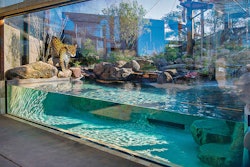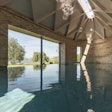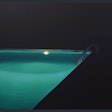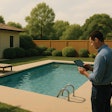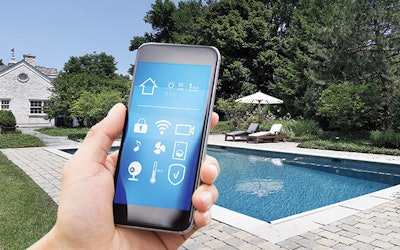
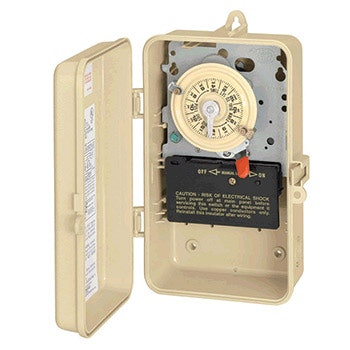
Control technology is a hot topic. In new pool construction, particularly on the more custom, high-end part of the spectrum, automation has become synonymous with luxury. Being able to control multiple pool, spa, lighting and landscape functions from mobile apps has proven a hook that many new pool owners cannot resist.
But that's not necessarily true in the aftermarket, especially when it comes to more so-called average or middle-class pools. For wide swaths of the existing pool market, many pools built before the rise of the smart machines are still operated the old-fashioned way, by turning valves and throwing switches. For many owners, simple mechanical time clocks still do the trick.
For some enterprising repair and renovation companies, this lingering absence of automation, coupled with more and more millennials coming into the pool-ownership market, spells opportunity.
THE AUTOMATION GAP
The notion that most pools remain unautomated may come as a surprise, given how vogue the technology has become, but we can only guess at the size of this untapped market. We know that there are somewhere north of 10 million existing pools in the U.S., but how many of those would qualify as "automated" is fuzzy.
According to Patrick McCarthy, senior editor CT Lab at NAPCO Media, publishers of Technology Integrator, "Swimming pool and spa automation is one of the largest markets in the outdoor arena. Recent research has pointed to the global pool equipment and maintenance market that is expected to gross $17
billion through 2022."
That lofty outlook does seem to be supported on an anecdotal basis. Indeed, those working in the aftermarket paint a picture of wide-open spaces when it comes to automation upgrades.
RELATED: Why Automation is Not Optional
Alan Smith Pool Plastering & Remodeling in Orange, Calif., serves a burgeoning remodel market, annually completing as many as 800 projects. This is a company that starts two to three new remodel projects every business day. With budgets ranging from $25,000 to $80,000 and higher, the company sees a broad spectrum of installations, the vast majority of which do not have automation.
Jeff Smith, director of sales and marketing and son of founder Alan Smith, sees significant growth potential in automating antiquated systems. "The majority of the pools we work on still don't have any type of automation," he says. "But, 99% of those we can fully automate, given the opportunity."
David Owens, owner of Owens Pools and Spas in Eugene, Ore., also estimates the market at more than half in his area. "I'd say in our market, 60% of the pools don't have automation," he says. "Of course, we are talking about pools that go back as far as the 1950s. I was recently asked to remodel a pool from 1961 that still has copper plumbing. In that case, we're replacing almost everything, so it will definitely have automation. There are definitely a lot of those pools out there."
MODERNIZING THE PAST
Despite the lucrative revenue stream controls and automation represent, some builders ignore the market entirely. According to Dan Lenz, vice president of All Seasons Pools and Spas (Orland Park, Ill.), "There are still builders who aren't installing automation on new pools."
Some of that may be due to the generation gap in automation technology. In communities dominated by older pool owners, there's less interest in the product. "Younger homeowners especially are interested in the simplicity and convenience of controlling their spa with their phone," Smith says. "Manufacturers have come a long way, and Wi-Fi itself has come a long way.
"Unfortunately," he adds, "we don't have a lot of those younger customers — at least not yet. The majority of our clients are older, with a lot of grandparents who are upgrading their pools to attract their kids and grandkids. When you have a pool that's 25 years old and you're replacing the equipment, some customers will want the modern technology, but there are still many who aren't interested. Looking ahead, there will certainly be more and more customers who are younger entering the housing market, and when that happens automation is going to be huge. It's only going to increase."
"There's definitely a generational aspect to this," Lenz agrees. "We're seeing an age group buying houses and running companies that are far more technology savvy. That's part of why I think we're going to see a significant change over the next handful of years, where automation and control, especially app-based applications, are going to be much more commonplace in the aftermarket compared to now. I truly believe that's going to increase in the relatively near future."
WHAT'S WORKING
Automation represents a large category of products that is constantly evolving in a sort of benign arms race among manufacturers, largely in terms of functionality and user interface. As mentioned above, app-driven control from devices is the contemporary automation calling card, but so too is the ability to expand systems to control LED lights, fire features and multiple pool functions such as attached spa modes, vanishing edge and perimeter overflow effects, in-floor cleaning systems, landscape lighting and other tangential features.
According to Lenz, one of the keys to success is first recognizing where existing pools can benefit from different levels of automation and being able to carry that message to the homeowner.
RELATED: Chemistry Automation: Always in Command
"Our service guys are well trained to immediately identify what a control system can do for our customers. And, when they have an opportunity, they're comfortable having those conversations," he says. "That's why we've established flat-rate pricing for just about everything you can do on a pool, and automation is one of those items. It's a powerful message: 'We can take you out of the stone age and put all these capabilities in the palm of your hand.'"
"We like to wear what we call our 10-year goggles, thinking years and years ahead," Smith says. "Our sales team is trained to think about what the customer can do years later. We're not really concerned about immediately selling everything on the menu; we want to establish long-term relationships. Planning for automation is one of those things we talk about with customers as something we can install later on.
"It's all about education," Smith adds. "Often the clients have no idea these products even exist because no one's ever explained it to them. Once they find out what's possible, then there's a good chance they'll want to go in that direction, now or in the future, and I believe that's only of our younger salespeople, once they become more familiar with the different systems on the market, then they're more comfortable sharing that information."
Automating an existing pool can mean a wide range of upgrades, far beyond simply turning the pump and lights on and off, and it's not always necessary to use an external control system. "The variable-speed pump comes with its own control system, which can be considered automation," Smith says. "The same is true for chemical automation. It tests the water and adds chemicals as you need them, that's also a form of automation that adds convenience and simplicity, and they don't require a separate system, but they're still major upgrades from the client perspective. There are those people who are just tired of walking over to the equipment set and turning valves manually, but they don't really care about 'apps.' It really just depends on the client."
Controlling LEDs is similar in that many newer product lines come with their own onboard controllers that instantly change colors. "With LED lights, a lot of people don't know anything about the technology and have the expectation that they can control the color very easily, the way you would with a regular white light," Smith says. "We have to proactively bring up that issue. We explain that when you have LED lights without automation, you have to push the switch up and down multiple times to rotate through the colors. Most don't like that idea, which makes it easy to talk about doing it with automation. Certainly, if they want some kind of light show, like red, white and blue on the 4th, then they'll definitely need a control system. We have to educate them up front."
MORE TO COME
Because automation is such a diverse category, routinely informing customers of their control options, and many other technical upgrades, has become part All Seasons' ongoing marketing strategy, Lenz explains.
"As an example, we did a major push when we were winterizing pools last year, where we had our service people identify anything they found on a pool that we could market to, anything you could think of. Automation was definitely part of that, along with variable speed pumps, LED lights, cartridge filters, new tile and pool finishes or new covers, you name it. We're using that information to build email campaigns targeting those customers who have a need and might be interested in any of those categories."
RELATED: Introducing the Unknown Control
"Our salespeople break everything out in a project by line items, so the client can pick and choose," Smith says. "They can do bits and pieces, saving some items for later. We are sensitive to budgets and we certainly don't pressure anyone to do everything at once. Sometimes automation is one of those items they plan on doing later in favor of more immediate needs.
"The market is definitely ripe for expansion," Smith concludes. "My hunch is that in the couple years we could double or even triple our automation sales. It's one of the areas where we can anticipate growth."




























